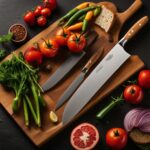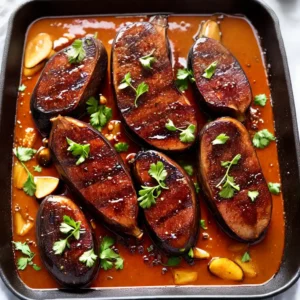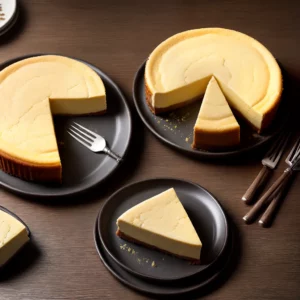As an expert chef, I know the importance of mastering the skill of cutting up a chicken breast. Whether you’re a beginner in the kitchen or a seasoned cook, knowing how to properly cut chicken breast opens up a world of culinary possibilities. From creating thin cutlets to dicing and butterflying, this skill is essential for various recipes.
Key Takeaways:
- Learning how to cut up a chicken breast is an essential skill in cooking.
- Thinner cutlets cook more rapidly and are perfect for searing or breading and frying in dishes like chicken marsala or chicken Parmesan.
- Mastering the art of cutting chicken breast enhances knife skills and expands your repertoire of cooking methods.
- To cut chicken breast, you will need a sharp chef’s knife or boning knife and a plastic cutting board.
- Proper knife skills, hygiene, and kitchen safety are crucial when cutting chicken breast.
Why Learning to Cut Chicken Breast is Important
As an expert chef, I cannot stress enough the importance of learning to cut chicken breast properly. Mastering knife skills and culinary techniques is essential for any aspiring cook or seasoned home chef. Cutting chicken breast opens up a world of possibilities in the kitchen, allowing you to explore various cooking methods and expand your repertoire of delicious poultry dishes.
By honing your knife skills, you gain better control and precision in the kitchen. Properly cutting chicken breast ensures that it is prepared correctly for different recipes, ensuring even cooking and maximizing flavor. Whether you’re slicing chicken breast into thin cutlets, dicing it for salads or stir-fries, or butterflying it for quicker cooking, knowing how to cut chicken breast properly is a fundamental skill that will elevate your culinary creations.
Moreover, learning to cut chicken breast enhances your overall kitchen skills. It sharpens your ability to handle ingredients efficiently and effectively, saving you time and effort during meal preparation. By understanding different cutting techniques, you become more versatile in the kitchen, capable of adapting to a variety of recipes and cooking styles. So, let’s dive into the world of chicken breast cutting techniques and unlock the full potential of this versatile poultry.
Kitchen Skills Enhanced by Learning to Cut Chicken Breast:
- Knife skills
- Culinary techniques
- Cooking methods
Learning to cut chicken breast opens up a world of culinary possibilities.
Tools Needed for Cutting Chicken Breast
As an expert chef, I understand the importance of having the right tools for cutting chicken breast. To ensure precise and safe cutting while maintaining the integrity of the chicken breast, you will need a few essential kitchen equipment. These include:
- A sharp chef’s knife or boning knife: A sharp knife will make the cutting process easier and more efficient. It should have a comfortable handle and a blade with a pointed tip for precise slicing.
- A plastic cutting board: Opt for a cutting board that is large enough to accommodate the size of the chicken breast. A plastic cutting board is easy to clean and sanitize, reducing the risk of cross-contamination.
With these tools at your disposal, you’ll be equipped to handle any cutting technique for chicken breast with ease and precision.
| Tool | Description |
|---|---|
| Sharp chef’s knife | A versatile knife with a pointed tip and a comfortable handle, ideal for precise cutting. |
| Boning knife | A knife with a narrow, flexible blade designed specifically for removing bones from meat. |
| Plastic cutting board | A hygienic and easy-to-clean surface for cutting and preparing food, reducing the risk of cross-contamination. |
Having the right tools is essential for successful chicken breast cutting. With a sharp knife and a suitable cutting board, you’ll be able to confidently and safely execute various cutting techniques for delicious recipes.

How to Cut Chicken Breast into Thin Cutlets
Mastering the art of slicing chicken breast into thin cutlets is a fundamental skill that every aspiring chef should learn. Thin cutlets not only cook faster, but they also offer a tender and juicy texture that elevates any dish. To achieve perfectly thin cutlets, follow these simple steps:
- Place a boneless, skinless chicken breast on a clean cutting board.
- Hold the chicken breast firmly with the palm of your non-knife hand.
- Using a sharp knife, carefully slice the chicken breast horizontally in half, creating two even pieces.
- Repeat this process for any additional chicken breasts you plan to cut.
By slicing the chicken breast horizontally, you ensure that the cutlets are uniform in thickness. This is crucial for even cooking, as each cutlet will be done at the same time. Whether you’re making a delicious chicken marsala or crispy chicken Parmesan, these thin cutlets will be the star of your dish.
| Benefits of Thin Cutlets | Cooking Tips |
|---|---|
|
|
Remember, mastering knife skills takes practice. Take your time and focus on precision to achieve beautifully thin cutlets every time.
Now that you know how to cut chicken breast into thin cutlets, you can explore a variety of cooking methods and recipes. From pan-seared cutlets to breaded and fried dishes, these thin cutlets will add depth and flavor to your culinary creations. Embrace your inner chef and showcase your knife skills with confidence!
Tips for Cutting Chicken Breast into Strips
When it comes to slicing chicken breast into strips, there are a few key tips and techniques to keep in mind. By following these guidelines, you can ensure that your strips are tender, evenly cooked, and perfect for a variety of dishes.
Proper Preparation
Before you start slicing your chicken breast into strips, it’s important to properly clean and dry the meat. This ensures that you have a clean surface to work with and helps prevent any potential contamination. Additionally, make sure to use a sharp knife. A dull knife can make the process more difficult and increase the risk of accidents.
Choosing the Right Cutting Technique
When cutting chicken breast into strips, it’s crucial to slice against the grain. The grain refers to the direction in which the muscle fibers of the meat run. By cutting against the grain, you’re creating shorter muscle fibers, resulting in a more tender texture.
The Slicing Process
To slice the chicken breast into strips, place the breast on a cutting board and hold it steady with one hand. Then, using a sharp knife, make thin, even slices perpendicular to the grain of the meat. Aim for strips that are about 1/2 inch wide.
Summary
Slicing chicken breast into strips requires proper preparation, such as cleaning and drying the meat, and using a sharp knife. It’s important to cut against the grain to ensure tender and evenly cooked strips. By following these tips, you’ll be able to create delicious and versatile chicken strips that can be used in various recipes.

How to Dice Chicken Breast
When it comes to dicing chicken breast, precision is key. This technique allows for even cooking and is perfect for recipes that require smaller, bite-sized pieces of chicken. To dice chicken breast, start by slicing it into strips. Then, cut the strips into smaller, 1-inch pieces. This method ensures uniformity and consistency in your diced chicken.
Here’s a step-by-step guide on how to dice chicken breast:
- Place the boneless, skinless chicken breast on a clean cutting board.
- Using a sharp knife, slice the chicken breast into thin strips, about 1/2 inch wide.
- Take the strips and cut them into smaller, 1-inch pieces.
- Repeat the process with the remaining chicken breast.
By dicing the chicken breast, you create versatile pieces that can be used in a variety of recipes. Whether you’re making a chicken stir-fry, salad, or pasta dish, diced chicken breast adds flavor and texture to your meals. It’s a simple yet effective knife skill that every home cook should master.
Butterflying Chicken Breast
One of the versatile techniques for preparing chicken breast is butterflying. This method involves cutting the chicken breast in half horizontally to create thinner and more even pieces. Butterflying not only reduces cooking time but also ensures that the chicken breast cooks evenly, resulting in moist and tender meat.
To butterfly a chicken breast, start by placing your hand on top of the breast to hold it steady. With a sharp knife, carefully slice through the middle of the breast, stopping just before reaching the other side. Be sure to maintain an even thickness throughout. Once you’ve made the initial cut, open the breast like a book, exposing the butterflied meat. At this point, you can choose to flatten the breast using a meat mallet if desired, which further ensures even cooking.
Butterflying chicken breast is particularly useful for recipes that require quick cooking, such as grilling, sautéing, or stuffing. The thinner pieces cook faster and allow for better flavor absorption. Additionally, butterflying can also be a great way to portion control larger chicken breasts, allowing you to have equal-sized servings for your meals.
| Benefits of Butterflying Chicken Breast | Technique |
|---|---|
| Reduces cooking time | 1. Place hand on top of chicken breast 2. Slice through the middle horizontally, stopping before reaching the other side 3. Open the breast like a book 4. Optional: Flatten the breast with a meat mallet |
| Ensures even cooking | 1. Maintain an even thickness throughout 2. Flatten the breast if desired |
| Allows for quicker flavor absorption | 1. Thin pieces cook faster 2. Enhances the absorption of marinades and seasonings |
Incorporating the butterflying technique into your cooking repertoire not only enhances your knife skills but also opens up a variety of culinary possibilities. The flattened and even pieces of chicken breast create a visually appealing presentation and ensure an enjoyable dining experience. So the next time you’re preparing chicken breast, consider butterflying it for a delicious and perfectly cooked meal.

Choosing the Right Knife for Cutting Chicken Breast
As an expert chef, I know that selecting the right knife for cutting chicken breast is essential for achieving precise and effortless cuts. A sharp knife not only makes the task easier but also ensures clean and even slices. When it comes to cutting chicken breast, two types of knives stand out: the chef’s knife and the boning knife.
1. Chef’s Knife
The chef’s knife is a versatile tool that every kitchen should have. Its long, curved blade allows for smooth slicing and rocking motion, making it ideal for cutting chicken breast into thin cutlets or strips. The chef’s knife offers better control and is suitable for various other tasks in the kitchen.
2. Boning Knife
If you’re looking for a knife specifically designed for cutting chicken breast, a boning knife is an excellent choice. With its narrow and flexible blade, the boning knife allows for precise maneuvering around bones and joints. This knife is perfect for butterflying chicken breast or removing any excess fat or skin.
When choosing between a chef’s knife and a boning knife, consider your personal preference and the specific task at hand. Both knives can effectively cut chicken breast, but the boning knife offers more precision for intricate cuts, while the chef’s knife provides versatility for a range of kitchen tasks.
Ensuring that you have a sharp knife is equally important. A dull knife can make the cutting process more difficult and increase the risk of accidents. Regularly sharpen your knife or seek professional sharpening services to maintain its effectiveness.
By selecting the right knife for cutting chicken breast, you’ll have the confidence and control necessary to create delicious meals with ease. Remember to handle your knife safely, maintain its sharpness, and enjoy the art of cooking!
How to Ensure Tender Chicken Breast by Cutting Against the Grain
When it comes to achieving tender and succulent chicken breast, one important technique to master is cutting against the grain. By understanding the anatomy of the meat and making precise cuts, you can transform tough and chewy chicken into tender and flavorful pieces.
When you look closely at a chicken breast, you’ll notice long muscle fibers running along its length. These fibers can be tough and chewy if not properly prepared. However, by cutting against the grain, you are essentially shortening these fibers, resulting in more tender meat.
To cut against the grain, examine the chicken breast and identify the direction in which the muscle fibers run. Once identified, use a sharp knife to slice perpendicular to these fibers. This technique breaks up the long fibers, making the chicken breast more tender and enjoyable to eat.
Mastering the art of cutting against the grain takes practice, but the results are well worth it. Your chicken breast dishes will be more tender and flavorful, elevating your cooking to a whole new level. So, the next time you’re preparing chicken breast, remember this simple but crucial technique to ensure a delicious outcome.
Preparing Chicken Breast for Specific Recipes
As an expert chef, I understand the importance of preparing chicken breast in various ways to suit specific recipes. Depending on the dish you are making, you may need to cut the chicken breast in a specific way to ensure optimal flavor and cooking results. By using different cooking techniques and honing your knife skills, you can create delectable meals that showcase the versatility of chicken breast.
One popular method is butterflying the chicken breast, which involves cutting it in half horizontally to create thinner pieces. This technique is ideal for recipes that require even cooking and reduced cooking time. Butterflied chicken breast works well in dishes like stuffed chicken breast or chicken roll-ups.
For recipes that call for thin, even pieces of chicken breast, such as stir-fries or sautés, you may need to slice the chicken breast into strips. By cutting against the grain, you ensure tender and flavorful strips that cook quickly and evenly. This technique is essential for achieving the desired texture and taste in stir-fry dishes.
“By using different cutting techniques, you can create a variety of exciting chicken breast dishes that are sure to impress your family and friends.”
If a recipe requires small, bite-sized pieces of chicken breast, dicing is the way to go. Start by slicing the chicken breast into strips and then cutting those strips into smaller, 1-inch pieces. This technique is perfect for adding chicken to salads, stir-fries, or grain bowls, providing bursts of flavor in every bite.
Different Cutting Techniques for Different Recipes
When preparing chicken breast for specific recipes, it’s essential to consider the cooking techniques involved. Whether you’re butterflying, slicing into strips, or dicing, always remember to use proper knife skills to ensure precision and safety in the kitchen. By mastering these cutting techniques, you can elevate your culinary creations and create dishes that are both visually appealing and delicious.
| Recipe | Cutting Technique |
|---|---|
| Stuffed Chicken Breast | Butterflying |
| Chicken Stir-Fry | Slicing into Strips |
| Chicken Salad | Dicing |

By using different cutting techniques, you can create a variety of exciting chicken breast dishes that are sure to impress your family and friends. Remember to follow the recipe’s instructions and adapt your cutting technique accordingly to ensure the best results. With practice and a bit of creativity, you can transform simple chicken breast into flavorful, restaurant-quality meals.
Tips for Cutting Chicken Breast for Meal Prepping
As an expert chef, I understand the importance of time-saving techniques in the kitchen. When it comes to meal prepping, cutting chicken breast efficiently can make a significant difference in your cooking shortcuts. By preparing chicken breast in advance, you can save valuable time during busy weekdays and ensure that you have a protein-packed ingredient ready for various dishes. Here are some tips for cutting chicken breast for meal prepping:
Tip 1: Portion Control
Before you start cutting the chicken breast, consider your portion sizes. It’s helpful to divide the breast into equal portions that will suit your meal prepping needs. Whether you prefer larger or smaller portions, having them pre-cut will make it easier to grab the right amount when assembling your meals.
Tip 2: Cubes or Slices
Depending on your meal recipes, you can choose to cut the chicken breast into cubes or slices. Cubes are great for stir-fries or skewers, while slices work well for salads or sandwich fillings. Determine which cutting style suits your intended recipes and prepare the chicken breast accordingly.
Tip 3: Proper Storage
After cutting the chicken breast, it’s crucial to store it properly to maintain freshness and prevent any contamination. Use airtight containers or resealable bags and make sure to label them with the date of preparation. Store the chicken breast in the refrigerator to keep it at a safe temperature until you’re ready to use it.
By following these tips, you can streamline your meal prepping process and ensure that cutting chicken breast becomes a time-saving technique in your kitchen. With pre-cut portions ready to go, you’ll be able to whip up delicious and nutritious meals in no time.
Essential Knife Skills for Cutting Chicken Breast
As an expert chef, I know that mastering essential knife skills is crucial when it comes to cutting chicken breast. Proper technique not only ensures safe and precise cutting but also enhances your culinary abilities. By honing your knife skills, you’ll be able to explore various cooking methods and expand your repertoire of delicious chicken breast recipes.
When it comes to cutting chicken breast, it’s essential to hold the chicken securely and use a smooth slicing motion. This allows for even and consistent cuts, ensuring that your chicken cooks evenly. Whether you’re creating thin cutlets, strips, or diced pieces, practicing proper knife skills will make the process more efficient and enjoyable.
Improving your knife skills goes beyond cutting chicken breast. It’s a valuable asset in the kitchen that can be applied to a wide range of ingredients and recipes. From slicing vegetables to preparing other types of meat, the ability to handle a knife with precision and control is a fundamental skill for any aspiring chef.
Advantages of Developing Knife Skills
- Efficiency: With proper knife skills, you’ll be able to cut chicken breasts quickly and effortlessly, saving you valuable time in the kitchen.
- Consistency: By mastering the art of cutting chicken breast, you’ll be able to create uniform pieces that cook evenly, resulting in perfectly cooked dishes.
- Versatility: Knife skills open up a world of culinary possibilities, allowing you to experiment with different cutting techniques and create a variety of textures and presentations.
- Safety: Learning proper knife skills not only ensures safe cutting practices but also reduces the risk of accidents and injuries in the kitchen.
So, the next time you’re preparing a chicken breast recipe, remember the importance of developing essential knife skills. Practice holding the chicken securely, use a smooth slicing motion, and enjoy the process of creating delicious meals with precision and confidence.

Table: Knife Skills for Cutting Chicken Breast
| Knife Skill | Description |
|---|---|
| Hold the Chicken Securely | Ensure a firm grip on the chicken breast to maintain control and prevent accidents. |
| Smooth Slicing Motion | Use a fluid and consistent slicing motion to create even and precise cuts. |
| Practice Consistency | Aim for uniform cuts to ensure even cooking and a professional presentation. |
| Technique Variety | Explore different cutting techniques such as butterfly, dice, or strips for versatile cooking options. |
| Knife Maintenance | Keep your knife sharp and in good condition for optimal cutting performance. |
Kitchen Safety Tips for Cutting Chicken Breast
When it comes to cutting chicken breast, prioritizing kitchen safety is of utmost importance. Not only does this help prevent accidents and injuries, but it also ensures the hygiene and cleanliness of your cooking process. Here are some essential safety tips to keep in mind:
1. Wash Your Hands Thoroughly
Before handling the chicken breast, always wash your hands with warm, soapy water for at least 20 seconds. This helps remove any potential bacteria or contaminants from your hands, reducing the risk of cross-contamination.
2. Use a Clean Cutting Board
Make sure your cutting board is clean and sanitized before you begin cutting the chicken breast. Using a plastic cutting board is recommended as it is easier to clean and less likely to harbor bacteria compared to wooden cutting boards. If possible, dedicate one cutting board solely for raw meat to avoid cross-contamination.
3. Use a Sharp Knife
A sharp knife is not just essential for efficient cutting, but it also reduces the risk of accidents. A dull knife requires more force and can slip, increasing the chances of injuring yourself. Keep your knives sharpened regularly and consider investing in a quality chef’s or boning knife for cutting through chicken breast.
By following these kitchen safety tips, you can ensure a safe and hygienic cutting process when preparing chicken breast for your favorite recipes.
Conclusion
In conclusion, mastering the skill of cutting chicken breast opens up a world of culinary possibilities. With the right techniques and tools, you can confidently prepare thin cutlets, strips, or diced pieces for a variety of delicious recipes. Cutting chicken breast properly is not only important for cooking evenly and efficiently, but it also enhances your overall culinary skills.
By learning how to cut chicken breast, you can control the thickness of the meat, ensuring that it is prepared correctly for various cooking methods. Whether you’re searing, breading, or stir-frying, properly cut chicken breast cooks more rapidly and results in tender and flavorful dishes.
Remember to always prioritize kitchen safety when handling raw chicken. Keep your cutting board clean, use a sharp knife to prevent accidents, and maintain proper hygiene to reduce the risk of contamination. With practice and attention to detail, you can elevate your cooking game and impress friends and family with your culinary expertise.
FAQ
What tools do I need to cut chicken breast?
You will need a sharp chef’s knife or boning knife and a plastic cutting board.
How do I cut chicken breast into thin cutlets?
Place a boneless, skinless chicken breast on a cutting board. Hold it flat with the palm of your non-knife hand and use a sharp knife to slice the chicken breast horizontally into two even pieces.
What is the best way to cut chicken breast into strips?
Start with a properly cleaned and dried breast. Use a sharp knife to slice the chicken breast against the grain, perpendicular to the muscle fibers.
How do I dice chicken breast?
Slice the chicken breast into strips and then cut the strips into smaller, 1-inch pieces.
What is butterflying chicken breast?
Butterflying involves cutting the chicken breast in half horizontally to create thinner pieces.
What knife should I use to cut chicken breast?
A sharp chef’s or boning knife is ideal for precise cutting.
Why is cutting against the grain important?
Cutting against the grain shortens the muscle fibers and makes the meat easier to chew.
How should I prepare chicken breast for specific recipes?
Follow the recipe’s instructions and use the appropriate cutting technique.
Can I cut chicken breast ahead of time for meal prepping?
Yes, you can cut the chicken breast into desired portions and store them in the refrigerator.
How can I develop good knife skills for cutting chicken breast?
Practice holding the chicken breast securely and using a smooth slicing motion.
What should I keep in mind for kitchen safety when cutting chicken breast?
Wash your hands thoroughly, ensure your cutting board is clean, and use a sharp knife to prevent accidents.
Source Links
- https://www.laurafuentes.com/cut-chicken-breasts/
- https://www.seriouseats.com/knife-skills-how-to-cut-chicken-breasts-into-cutlets
- https://josieandnina.com/how-to-cut-chicken-breast/
Related Recipes:
 How to Cut Up a Chicken Breast for Recipes
How to Cut Up a Chicken Breast for Recipes
 How to Cut a Tomato? (Perfect Step-By-Step Guide)
How to Cut a Tomato? (Perfect Step-By-Step Guide)
 How to Cut a Tomato: Techniques for Every Dish
How to Cut a Tomato: Techniques for Every Dish
 How to Cut a Whole Chicken: Tips and Tricks
How to Cut a Whole Chicken: Tips and Tricks
 Cleaning Plastic Cutting Boards: Tips and Tricks
Cleaning Plastic Cutting Boards: Tips and Tricks
 Essential Kitchen Knives for Every Beginner
Essential Kitchen Knives for Every Beginner
 How to Cut Mushrooms? (Perfect Step-By-Step Guide)
How to Cut Mushrooms? (Perfect Step-By-Step Guide)
 How to Cut Broccoli: A Quick Guide
How to Cut Broccoli: A Quick Guide







